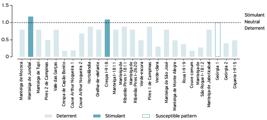ABSTRACT:
Collard greens Brassica oleracea var. acephala is one of the most important horticultural grown in Brazil for human feeding. The caterpillar Ascia monuste orseis (Lepidoptera: Pieridae) stands out among the important pest in Brassicaceae causing severe plant defoliation. The objective of this study was to identify resistant genotypes (antixenosis) in 26 collard greens genotypes to A. monuste orseis. In free-choice test, randomized blocks were used; and in the non-choice test we adopted a completely randomized design. Manteiga de Jundiaí, crespa de Capão Bonito, couve de Arthur Nogueira 1, manteiga I-1811, manteiga de Ribeirão Pires I-1811, orelha-de-elefante and Pires 1 de Campinas presented antixenosis (non-preference for oviposition). Pires 1 de Campinas, manteiga I-1811, manteiga de São José, verde-escura and manteiga de Monte Alegre presented antixenosis (non-preference for feeding). These collard greens genotypes can be directly used by farmers for cultivation or by breeders as donor sources in breeding programs for resistance to A. monuste orseis.
KEYWORDS:
Great southern white; plant resistance to insect; Brassicaceae; integrated pest management

 Thumbnail
Thumbnail
 Thumbnail
Thumbnail
 Thumbnail
Thumbnail
 Thumbnail
Thumbnail
 Thumbnail
Thumbnail




